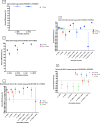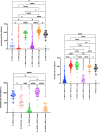Immunogenicity and real-world effectiveness of COVID-19 vaccines in Lebanon: Insights from primary and booster schemes, variants, infections, and hospitalization
- PMID: 39269963
- PMCID: PMC11398646
- DOI: 10.1371/journal.pone.0306457
Immunogenicity and real-world effectiveness of COVID-19 vaccines in Lebanon: Insights from primary and booster schemes, variants, infections, and hospitalization
Abstract
In this study, we conducted a case-control investigation to assess the immunogenicity and effectiveness of primary and first booster homologous and heterologous COVID-19 vaccination regimens against infection and hospitalization, targeting variants circulating in Lebanon during 2021-2022. The study population comprised active Lebanese military personnel between February 2021 and September 2022. Vaccine effectiveness (VE) against laboratory-confirmed SARS-CoV-2 infection and associated hospitalization was retrospectively determined during different variant-predominant periods using a case-control study design. Vaccines developed by Sinopharm, Pfizer, and AstraZeneca as well as Sputnik V were analyzed. Prospective assessment of humoral immune response, which was measured based on the SARS-CoV-2 antispike receptor binding domain IgG titer, was performed post vaccination at various time points, focusing on Sinopharm and Pfizer vaccines. Statistical analyses were performed using IBM SPSS and GraphPad Prism. COVID-19 VE remained consistently high before the emergence of the Omicron variant, with lower estimates during the Delta wave than those during the Alpha wave for primary vaccination schemes. However, vaccines continued to offer significant protection against infection. VE estimates consistently decreased for the Omicron variant across post-vaccination timeframes and schemes. VE against hospitalization declined over time and was influenced by the variant. No breakthrough infections progressed to critical or fatal COVID-19. Immunogenicity analysis revealed that the homologous Pfizer regimen elicited a stronger humoral response than Sinopharm, while a heterologous Sinopharm/Pfizer regimen yielded comparable results to the Pfizer regimen. Over time, both Sinopharm's and Pfizer's primary vaccination schemes exhibited decreased humoral immunity titers, with Pfizer being a more effective booster than Sinopharm. This study, focusing on healthy young adults, provides insights into VE during different pandemic waves. Continuous research and monitoring are essential for understanding vaccine-mediated immune responses under evolving circumstances.
Copyright: © 2024 Moghnieh et al. This is an open access article distributed under the terms of the Creative Commons Attribution License, which permits unrestricted use, distribution, and reproduction in any medium, provided the original author and source are credited.
Conflict of interest statement
The authors have declared that no competing interests exist.
Figures





References
-
- Brunson EK, Chandler H, Gronvall GK, Ravi S, Sell TK, Shearer MP, et al. The SPARS pandemic 2025–2028: A futuristic scenario to facilitate medical countermeasure communication. Journal of International Crisis and Risk Communication Research. 2020. Jan 1;3(1):71–102. https://stars.library.ucf.edu/jicrcr/vol3/iss1/4/
-
- World Health Organization (WHO). Current context: the COVID-19 pandemic and continuing challenges to global health Geneva: World Health Organization (WHO); 2023. updated [accessed: 10 September 2023]. Available at: https://www.who.int/about/funding/invest-in-who/investment-case-2.0/chal....
-
- Gordon RJ. Did Economics Cause World War II?. National Bureau of Economic Research; 2008. Dec 11.
MeSH terms
Substances
Supplementary concepts
LinkOut - more resources
Full Text Sources
Medical
Miscellaneous

